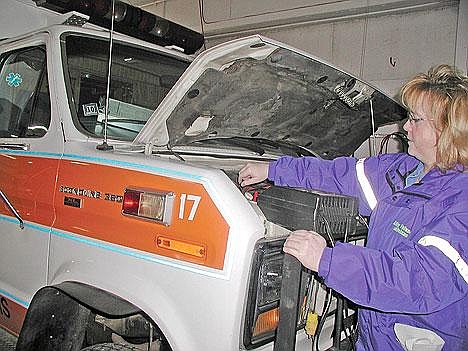Ballot measure would raise ambulance levy
By GWEN ALBERS Western News Reporter
Pat Shira counts on a dependable ambulance when working the night shift for Troy Volunteer Ambulance - not only for herself but for the person in need.
That's why Shira, an emergency medical technician and president of Lincoln County Ambulance Board, hopes voters on Nov. 7 will support a 2-mill tax increase for volunteer ambulance companies in Libby, Troy and Eureka.
The extra $50,000 a year from the tax would enable each company to buy an ambulance every six years. Right now, it's every 12 years.
"If you call 911, you'd like a dependable ambulance," Shira said.
For the first time in 14 years, Lincoln County voters will be asked to support a tax increase for new ambulances.
Currently, the owner of a home valued at $100,000 pays $7.38 annually for ambulance service. If approved, that bill would jump to $11.65 a year.
New ambulances at one time cost $60,000 to $65,000. Now they're $100,000 to $110,000, said Dick Wernham, a member of the county ambulance board and Libby Volunteer Ambulance.
One mill of taxes currently is designated for new ambulances. That mill generates $25,000 annually. So it takes four years for one volunteer company to get enough money to buy an ambulance.
"With 1 mill, you can't keep up with purchasing new ambulances since they've gone up significantly," Wernham said.
Five aging ambulances concerns Charles McFarland, president of Libby Volunteer Ambulance.
"I did a juggling act the last five years to keep everything running with used ones," McFarland said. "A couple years down the road, it will bite me. I've got to buy a new one."
The cheapest new ambulance he found is $110,000, he said.
Right now, Libby's newest ambulance is seven years old. Pine Bush Volunteer Ambulance in New York earlier this year donated it. Libby Ambulance in 2002 purchased its second newest ambulance - a used rig also from Pine Bush.
A third ambulance came from Los Angeles. It too is used. The 1998 ambulance has 105,000 miles.
"It's starting to nickel and dime us," McFarland said. "It needed brakes, a fuel pump, alternator and transmission work."
Libby Volunteer Ambulance gets 1,250 calls annually, or about three to four a day. It keeps ambulances on the road.
"They get a real beating," McFarland said. "We start them cold and run them hard. We're putting a lot of money in to keep them going."
Libby Ambulance responds to emergencies as far as Happy's Inn to the southeast, Kootenai Falls to the west and Wolf Creek to the north. Sometimes a run can take eight to 10 hours.
Libby relies on billing insurance companies, Medicare and private pay patients for its $175,000 annual budget to serve a 1,430-square-mile area.
Troy is a little better off than Libby.
Three years ago, when it was Troy Volunteer Ambulance's turn to benefit from the tax money, the company purchased a new, $100,000 four-wheel drive ambulance.
"It has about 35,000 miles on it and is our primary transport vehicle," Shira said. "Our others are a 1994 and 1995. We have one at Bull Lake and another in Troy."
Troy Volunteer Ambulance needed the four-wheel drive because more people are living in the remote areas. The company serves a 1,200-mile area including the Yaak.
"They have no service in the Yaak. We are the primary responder," Shira said.
The county's three ambulance companies responded to a total of 1,800 calls last year and put on more than 100,000 miles combined, Wernham said.
"Libby has a lot of short runs, but we have a lot of runs," he said. "Eureka, on the other hand, when they have to haul someone, has to go to Whitefish. That's a 50-mile run."

